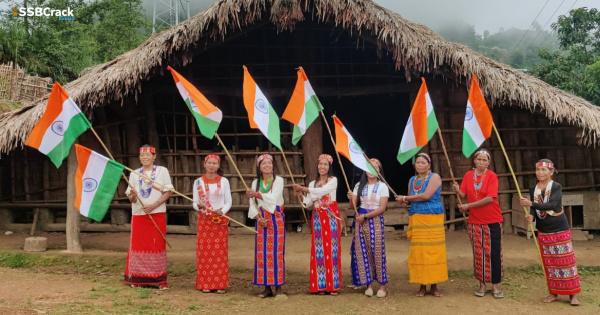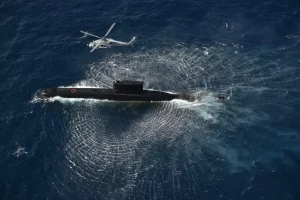The Tri-colour flag is a symbol of pride for every Indian. It represents national integrity and signifies the hopes and aspirations of the Indian people. Har Ghar Tiranga’ is a campaign under the aegis of Azadi Ka Amrit Mahotsav to encourage people to bring the Tiranga home and to hoist it to mark the 75th year of India’s independence.
Our relationship with the flag has always been more formal and institutional than personal. Bringing the flag home collectively as a nation in the 75th year of independence thus becomes symbolic of not only an act of personal connection to the Tiranga but also an embodiment of our commitment to nation-building. The idea behind the initiative is to invoke the feeling of patriotism in the hearts of the people and to promote awareness about the Indian National Flag.
Pingali Venkaya’s Design of the National Flag
The tricolour flag, which symbolizes pride for every Indian, which motivates the freedom fighters towards a single goal of independence, holds a unique place in every Indian’s heart.
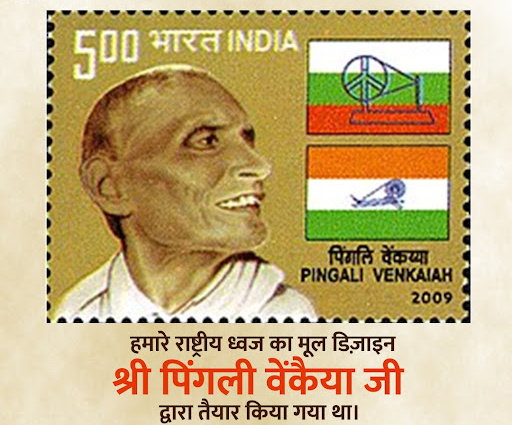
The Indian flag, in its present form, has three equal, parallel, and rectangular stripes of saffron (Kesari), white, and green. A blue-coloured Dharma Chakra or ‘Wheel of the Law’ with 24 spikes is placed in the centre of the white band. The Saffron signifies courage, sacrifice, and the spirit of renunciation; white signifies purity and truth, and green stands for faith and fertility. The Chakra denotes the continual progress of the country. Its blue colour connotes the boundless sky and fathomless sea. The founding fathers of India wanted limitless growth for the nation. The flag, as we see it today, has gone through various changes before taking its present shape.
The first Indian flag came into being in the pre-independence era, in 1904. It was made by Sister Nivedita, an Irish disciple of Swami Vivekananda. This flag had two colours, red and yellow, wherein red signified the freedom struggle and yellow was a symbol of victory. The words Bande Mataram in Bengali script were written on it. The flag also contained a figure of Vajra, the weapon of the Hindu deity Indra, and a white lotus in the middle. The Vajra is a symbol of strength, and the lotus depicts purity. Another flag was designed in 1906, which was a tricolour flag with three equal strips – blue at the top, yellow in the middle, and red at the bottom. In this flag, the blue strip had eight stars of slightly different shapes. The red strip had two symbols: the first one was of the sun, and the other one contained a star and a crescent. The yellow strip had the words Vande Mataram written on it in Devanagari script. In the same year, another version of tri-colour was created, which had orange, yellow, and green colours. It came to be known as the ‘Calcutta Flag’ or the ‘Lotus Flag’, as it had eight half-opened red coloured flag had a comparatively larger size of flowers.
In 1921, Pingali Venkaya, a young man from a small village near Machilipatnam, in present-day Andhra Pradesh, designed a flag which had white, red, and green colours with a Charkha or a spinning wheel in the centre. This flag was rejected as it represented the colours of religious communities.
In 1931, the ‘Swaraj’ flag came into existence, which had a close resemblance to our present National flag. This tricolour flag had the same saffron, white, and green colours as in our current National flag. The only difference was that instead of a Dharma Chakra, it had a Charkha adopted by the Constituent Assembly.
24 Spokes of the Dharma Chakra in the National Flag
A flag stands as the identity of a nation. Though many organizations, communities, armed forces, offices, or individuals have been using their flags since time immemorial, today people associate Page 1 more with their national flags. A national flag is not restricted to any community or office. Instead, it belongs to each and every citizen of a nation.
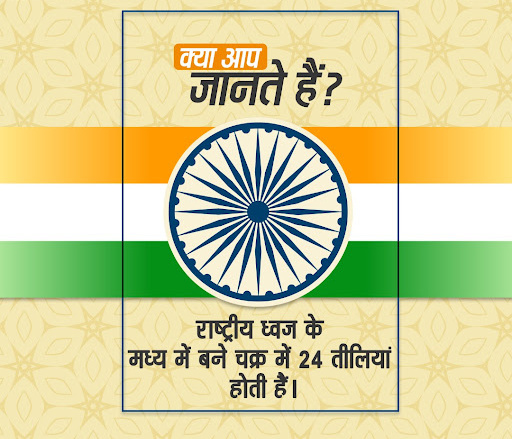
India adopted a tricolour flag with a Chakra in the centre as its national flag, which represents the pride of the nation. Our national flag reminds us of the country’s long struggle for freedom. During the country’s independence movement, it was a symbol of solidarity among the nationalists, and today, in independent India, it has become a symbol of unity and patriotism. Our flag is made up of three colour bands of equal width: the top being saffron (Kesari), white in the middle, and green at the bottom. In the centre of the white band, there is a navy-blue wheel with 24 spokes (Dharma Chakra).
The saffron, or the Kesari colour, signifies strength and courage, while the white colour in the middle is a symbol of peace and purity. The green colour at the bottom signifies fertility and growth. The navy blue-coloured Dharma Chakra in the centre of the white band is made up of 24 spokes. It depicts motion, signifying persistent efforts and progress. This ‘Wheel of the Law’ has been derived from the Lion Capital of the great Mauryan Emperor Ashoka, which was discovered at Sarnath, near Varanasi. Our national flag does not only stand as our national pride but also acts as a motivating force, which encourages us towards strength and courage, peace and truthfulness, fertility and growth, and incessant efforts towards nation building.
As per the Flag Code of India, the National Flag should be rectangular in shape. The ratio of its width to its length is two is to three. The National Flag of India should be made up of hand-spun and hand-woven wool/ cotton/ silk khadi bunting. The hand-woven khadi for the National Flag was initially manufactured at Garag, a small village in Dharwad district in north Karnataka.
The Indian National Flag in its present form was adopted at the meeting of the Constitutional Assembly on 22 July 1947. It first served as the National Flag of the Dominion of India from 15 August 1947 to 26 January 1950 and thereafter as the National Flag of the Republic of India.
The Indian National Flag is based on a flag designed by Pingali Venkayya, a freedom fighter, who was a staunch follower of Mahatma Gandhi. He was born at Bhatlapenumarru, near Machilipatnam, in present-day Andhra Pradesh. Today, under the programme, ‘Har Ghar Tiranga’, when we head towards hoisting a Tiranga at every home, care should be taken that it should not be damaged in any form, and no other flag should be placed higher than, above, or side by side with our national flag.
Tiranga: A Symbol of Victory
On 15 January 2022, on the occasion of the Army Day, the Indian Army unveiled the world’s largest Tiranga, as the Indian National Tricolour Flag is popularly called, at Jaisalmer. It was made of khadi and measured 33,750 sq. ft.!!
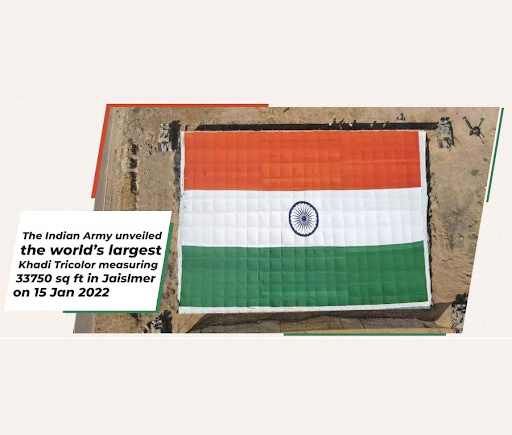
The Tiranga has been a symbol of our national pride, which reminds us of the struggles and sacrifices made by the great freedom fighters for the cause of independence. Page 1 With the flag in our hands, we won freedom for our country, and in due course of time, it became a mighty symbol of our victory in each and every sphere of life. Be it a cricket match, or an achievement in the Olympics; be it a musical concert abroad, or an achievement in space and science; be it at home or an event on foreign soil, a victory is always celebrated by the unfurling of the Tiranga.
Beginning from the time when India won freedom from the British rule at the stroke of midnight on 15 August 1947, every victorious event has been marked by the unfurling of the Tiranga. It has become a ceremonial symbol of our victory, uniting every Indian in a single thread of patriotism. Whether it was the India-Pakistan War of 1965, or the occasion of Bangladesh’s liberation in 1971; or for that matter Operation Vijay at Kargil in 1999, India’s victory was always celebrated by hoisting the Tiranga high in the sky. After independence, when India won the first gold in the Olympics, the pride and celebration got a striking reflection through the waving the national flag.
Years later, when Abhinav Bindra secured gold in Men’s 10m Air Rifle Shooting in the Beijing Olympics of 2008; and when Neeraj Chopra won gold in Men’s Javelin Throw in the Tokyo Olympics of 2020, the national flag was proudly held high at these international fora. Similarly, when the Indian Cricket team won the World Cup for the first time in 1983, feelings of pride and celebrations were reflected through the Tricolour flying high. This became a beautiful tradition, and when the first T-20 World Cup was won by India, the feelings of the proud nation got a similar reflection in the proudly fluttering Tiranga.
At the successful launch of the Chandrayaan or the Mangalyaan, Tiranga again represented the overwhelming feelings of the proud nation. The feelings of patriotism and solidarity are reflected by the national flag waving high in the sky. Inspired by the notion, the Indian Army unveiled the world’s largest khadi Tricolour, measuring 33,750 sq. ft. in Jaisalmer, on 15 January, 2022.
Even though every Indian has a deep respect for, and loyalty to, the National Flag, a perceptible lack of awareness is often noticed, not only amongst people but also in the organizations/ agencies of the government, with regard to laws, practices, and conventions that apply to the display of the National Flag.
With all the enthusiasm and amidst all the celebrations, we need to follow the norms prescribed in the Flag Code of India and take care that when the National Flag is hoisted horizontally, the saffron band should always appear on the top. It should not touch the ground, the floor or trail in water. The Tricolour reminds us of our deep-rooted national ideology, which played a significant role in the formation of the India that we know today.
Rare And Unseen
It was the pre-independence era. World War II had impacted the entire world. On 30 December 1943, the Indian National Army, under the leadership of Netaji Subhas Chandra Bose, declared the Andaman and Nicobar Islands as part of Independent India and renamed them ‘Shaheed-deep’ (Martyr Island) and ‘Swaraj-dweep’ (Self-ruled Island).
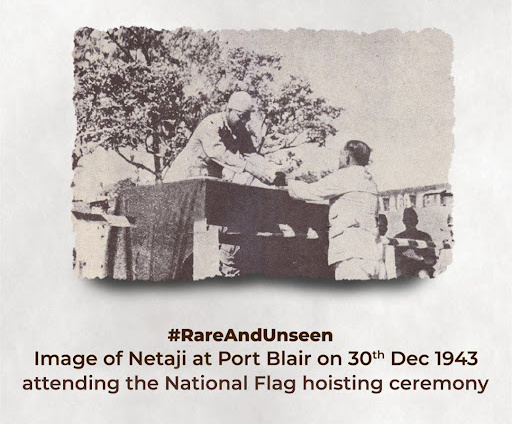
On this occasion the Indian tri-colour was hoisted at the Gymkhana Ground (now Netaji Stadium) in Port Blair by Netaji as the Prime Minister of the Azad Hind Government. Later, Indian National Army’s General A. D. Loganathan was appointed as Governor of the region. With this achievement, the Azad Hind Government did not remain merely a government in exile anymore but had its own land, own anthem, civil code, stamps, radio station, bank and other organs of the administration.
Very few people might be aware of the fact that the anthem of the Azad Hind Government was very similar to our current national anthem. The anthem read as: “शुभ, सुख, चैन की बरखा बरसे, भारत भाग्य है जागा…” (Shubh, Sukh, Chain ki barkha barse, Bharat-Bhagya hai jaga…). Fast forward to 30 December 2018, on the 75th anniversary of the Azad Hind Government, the Prime Minister of India, Shri Narendra Modi, again hoisted the tricolour at Port Blair to pay hearty tribute to Netaji Subhas Chandra Bose and to commemorate the achievement of the Indian National Army.
He also renamed the Neil and Havelock islands as ‘Shaheed Dweep’ and ‘Swaraj Dweep’, whereas Ross Island was named as ‘Netaji Subhas Chandra Bose Island’. The 150-foot-tall tricolour stands tall to pay the nation’s emotional tribute to our beloved leader.
Our relationship with the flag has always been more formal and institutional than personal. Bringing the flag home collectively as a nation in the 75th year of independence thus becomes symbolic of not only an act of personal connection to the Tiranga but also an embodiment of our commitment to nation-building, The idea behind the initiative is to invoke the feeling of patriotism in the hearts of the people and promote awareness about our national flag.
To crack the SSB Interview, You can join our SSB interview live classes batch and we recommend you to Enroll SSB INTERVIEW ONLINE COURSE. Trusted by thousands of defence aspirants.
